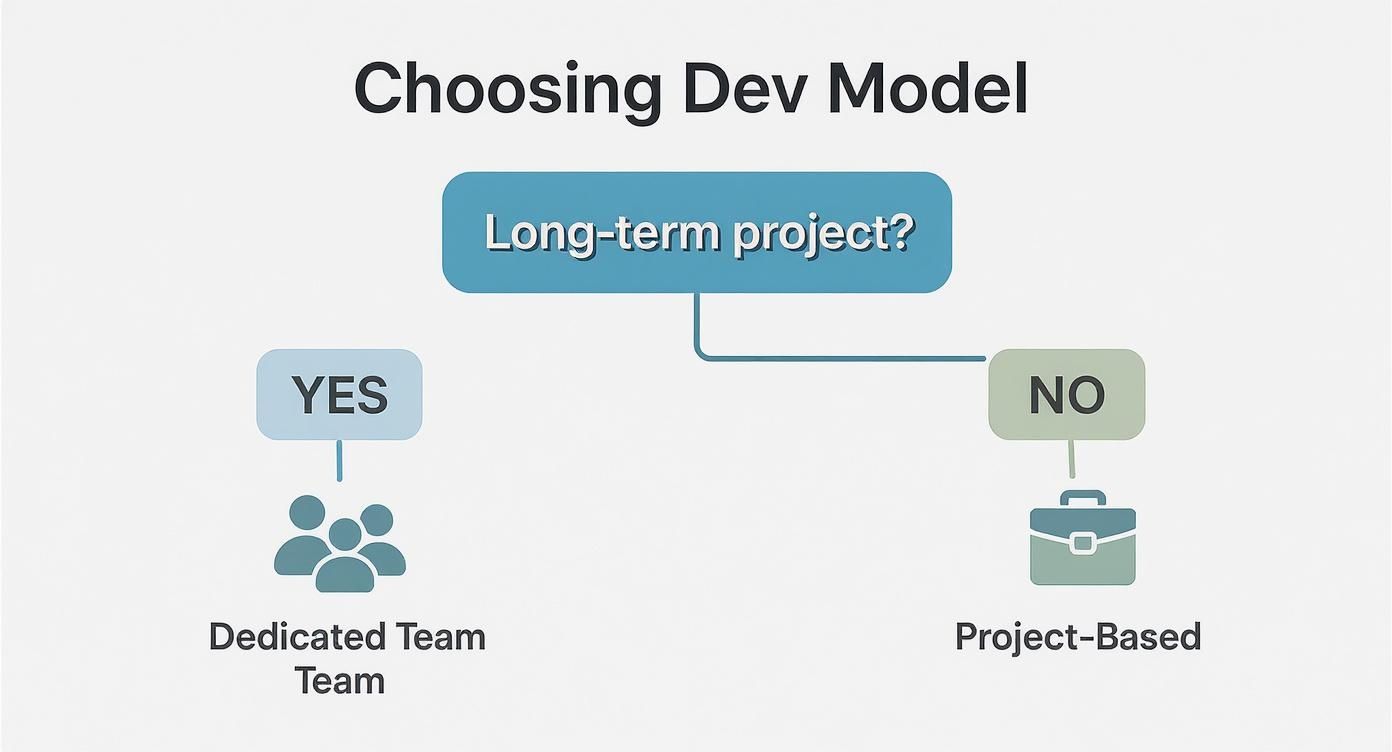dedicated development team model: Build and scale teams
Think of it like this: if you wanted to build a championship race car, you wouldn’t just hire a random mechanic for a few hours. You’d assemble a world-class crew—engineers, pit crew, a driver—all working exclusively for you, laser-focused on one thing: winning.
The dedicated development team model applies that same logic to building great software.
What Is a Dedicated Development Team?
In simple terms, a dedicated development team is a long-term partnership where a technology provider gives you a full crew of software experts who work only on your project. They aren’t freelancers juggling multiple clients or a project-based team that disbands after launch.
They become a genuine, remote extension of your own company.
This team is 100% committed to you. They dive deep into your company’s goals, learn your internal workflows, join your Slack channels, and adopt your culture. They are your team, just located elsewhere.
What’s the trade-off? You get total control over the project’s direction and day-to-day priorities, but you get to offload all the administrative headaches. Your partner handles the recruiting, payroll, benefits, and office space, freeing you up to focus on what really matters: building an amazing product.
The Core Principles of the Model
So, what makes this model tick? It really boils down to a few key ideas that separate it from other outsourcing options.
- It’s a Marathon, Not a Sprint: This model is built for long-term, complex projects. The team sticks around, builds deep expertise in your product and industry, and grows alongside your business.
- True Integration: They don’t just work for you; they work with you. The team plugs directly into your project management tools (like Jira or Asana), attends daily stand-ups, and aligns completely with your business strategy.
- You’re in the Driver’s Seat: You have a direct line to every team member. You set the priorities and manage their workload, ensuring their efforts are always locked on your most critical business needs.
- Flexible and Scalable: Need to add a QA engineer or a DevOps specialist halfway through? No problem. A dedicated team setup lets you scale your crew up or down quickly, without the months-long slog of traditional hiring.
The dedicated team model isn’t new; it’s a battle-tested approach that has been refined for over 20 years. It’s become so essential that by 2025, an estimated 92% of Forbes Global 2000 companies will use IT outsourcing in some form, with dedicated teams leading the charge for sustained innovation. You can dive deeper into this trend in AgileEngine’s comprehensive guide.
To give you a clearer picture, here’s a quick breakdown of the model’s essential traits.
Core Characteristics of the Dedicated Development Team Model
| Characteristic | Description | Primary Benefit |
|---|---|---|
| Exclusive Focus | The team works solely on your project, with no distractions from other clients. | Unwavering commitment and deep product knowledge. |
| Long-Term Partnership | Contracts are typically for a year or longer, fostering stability and team cohesion. | Consistent progress and lower team turnover. |
| Client Management | You directly manage the team’s tasks, priorities, and overall project direction. | Full control over the development process and outcomes. |
| Vendor HR Responsibility | The partner handles all administrative tasks like recruitment, payroll, and benefits. | Reduced administrative burden and faster team setup. |
| Deep Integration | The team adopts your tools, communication channels, and company culture. | A seamless extension of your in-house staff. |
Ultimately, the dedicated team model offers the best of both worlds: the focused loyalty of an in-house team combined with the flexibility and cost-efficiency of a global talent pool.
How It Works in Practice
The process is refreshingly straightforward. You start by outlining the skills you need and the size of the team you envision. Your technology partner then takes over, handling the entire recruitment and vetting process to assemble a team perfectly matched to your requirements.
Once the team is in place, they report directly to your internal manager. From day one, they are a fully integrated part of your organization, ready to hit the ground running for the entire lifecycle of the project.
Choosing the Right Development Model for Your Business
Picking the right development approach is one of the most important calls a business can make. This isn’t just about hiring people to write code; it’s about building the very engine that will drive your company’s growth. It has to be a perfect match for your budget, your timeline, and where you see the business going in the long run. The dedicated development team model is incredibly powerful, but it’s certainly not a one-size-fits-all solution.
So, how do you know if it’s the right move for you? It really comes down to understanding the DNA of your project.
Are you building a complex, ever-evolving product that will be the heart of your business for years? If that’s the case, a long-term, deeply integrated partnership is a must. A dedicated team absolutely shines in this kind of environment, becoming genuinely invested in your success.
On the other hand, if you’re looking at a small, tightly-defined project with a clear finish line—think a simple marketing website—a project-based model is probably a smarter, more efficient choice. The trick is to align the engagement model with the strategic weight and expected lifespan of your project.
When to Choose a Dedicated Team
Some situations are practically a flashing sign that a dedicated team is your best bet. If your business fits one of these descriptions, this model should be high on your list of considerations.
- You Have a Long-Term Vision: Your project isn’t a one-and-done task. It’s a multi-year roadmap packed with features that will change and grow. A dedicated team brings the continuity and deep product knowledge you need to successfully navigate that journey.
- Your Project Scope Is Dynamic: If customer feedback and user testing are going to constantly reshape your product, you need a team that can turn on a dime. The dedicated model gives you the flexibility to shuffle priorities without getting bogged down in contract renegotiations.
- You Need to Scale Predictably: Your startup just closed a funding round and you need to ramp up development, fast. A dedicated team allows you to bring on vetted engineers in weeks, not months, letting you sidestep the painfully slow and expensive traditional hiring process.
- You Have Critical Skill Gaps: Maybe the local talent pool just doesn’t have the experts you need in a specific tech stack, like AI or blockchain. This model opens up a global reservoir of specialists who can fill those gaps right away.
A dedicated team is far more than just outsourced labor; it’s a strategic partnership. This model is built for businesses that see technology not as a cost center, but as a core driver of their competitive advantage and long-term value.
Comparing Your Development Options
To really make the right call, you need to see how the dedicated team model stacks up against the other common approaches. Each has its own strengths depending on what you need in terms of control, cost, and commitment. The choice between a remote dedicated team and a local in-house one also has its own set of trade-offs. For a deeper look, you can explore the pros and cons of office vs. remote work to see which arrangement best fits your company’s vibe.
To help you compare, we’ve put together a table breaking down the key differences across the four main models.
Dedicated Team vs In-House vs Staff Augmentation vs Project-Based
| Factor | Dedicated Team | In-House Team | Staff Augmentation | Project-Based |
|---|---|---|---|---|
| Control | High. You manage the team’s daily tasks and long-term priorities directly. | Highest. Complete control over every aspect of the team and process. | Medium. You manage the augmented staff, but they remain employees of the vendor. | Low. You provide requirements; the vendor manages the entire process. |
| Cost | Medium. Lower than in-house due to reduced overhead but more than project-based. | Highest. Includes salaries, benefits, recruitment, and infrastructure costs. | Medium. Pay for specific skills as needed, avoiding full-time hiring costs. | Low. A fixed price for a defined scope, making it highly predictable. |
| Scalability | High. Easily scale the team up or down with your partner’s help. | Low. Scaling is slow and expensive, requiring a full hiring cycle. | High. Perfect for adding one or two specialists for a short period. | Very Low. Scaling often requires a new contract and scope negotiation. |
| Commitment | High. Team is 100% focused on your project for the long term. | High. Employees are fully dedicated to the company’s success. | Low. Staff are loyal to their employer, not necessarily your project. | Low. The team is committed only to the project scope and disbands after. |
| Integration | Deep. Becomes a seamless extension of your company culture and workflow. | Full. Completely integrated as they are part of the core organization. | Partial. Individuals integrate into a project but not fully into the company. | Minimal. Operates as an external vendor with limited cultural integration. |
When it comes down to it, the best choice hangs on your strategic goals. If you need a fully committed, scalable, and cost-effective team for a core, long-term product, the dedicated development team model offers a powerful and well-balanced solution.
Assembling Your High-Performing Dedicated Team
Putting together a dedicated development team is a bit like casting for a blockbuster movie. You don’t just grab a list of A-list actors; you need the right actors for each specific role, people who have chemistry and can work together to create something incredible. It’s the exact same principle here: your success hinges on building a balanced team with the specific technical and soft skills your project needs to thrive.
Think of a typical dedicated team as a well-oiled machine with several core parts. Each role is distinct, yet they all work in sync to take your project from a concept to a polished, market-ready product. While the specific lineup can change based on the project, most high-performing teams are built on a few essential pillars.
Core Roles in a Dedicated Team Structure
The foundation of any solid software project is a clear division of labor. Here are the key players you’ll almost always find in a dedicated team setup:
- Project Manager (PM): This is your director. The PM is your main point of contact, making sure the team’s work aligns with your business goals, managing schedules, and keeping communication flowing smoothly between everyone involved.
- UI/UX Designer: The architect of the user experience. This person’s job is to make your product not just functional but genuinely intuitive and enjoyable to use. They create the wireframes, prototypes, and user flows that act as the blueprint for development.
- Backend Developers: These are the engineers building the engine under the hood. They handle the server-side logic, databases, and APIs that make your application run. It’s the invisible work that everything else depends on.
- Frontend Developers: These are the specialists who build everything the user actually sees and touches. They take the UI/UX designs and bring them to life as a real, interactive interface on a browser or device.
- QA Engineers: Think of them as the quality guardians. These experts test the application from top to bottom, hunting down bugs and ensuring the final product is stable, secure, and ready for launch day.
This decision tree gives you a good idea of how the nature of your project points toward the best model.
As the visual shows, long-term, evolving projects are a perfect match for the dedicated development team model. On the other hand, short-term tasks with a fixed scope are often better handled with a project-based approach.
Finding the Perfect Balance of Skills
Beyond just filling roles, the real art is balancing the seniority levels on your team. A team packed with senior developers might sound like a dream, but it’s often overkill and incredibly expensive. At the same time, a team of only juniors can bog down progress and create quality headaches.
A proven strategy is to aim for a healthy mix of talent. A common and effective structure is a 30-40-30 distribution across junior, mid-level, and senior specialists. This blend gives you strong mentorship from seniors, reliable execution from mid-level developers, and cost-efficiency from juniors, creating a development engine that’s both effective and sustainable. You can get more details on this strategy from AgileEngine’s insights on the dedicated team model.
The X-Factor Soft Skills for Success
Technical chops will get a candidate in the door, but it’s the soft skills that turn a dedicated team into a true long-term partner. You can teach someone a new coding language, but the right mindset is priceless.
The difference between a group of programmers and a high-performing team isn’t just code quality—it’s communication, ownership, and a shared commitment to the project’s vision.
When you’re vetting candidates, keep an eye out for these crucial traits:
- Proactive Communication: People who aren’t afraid to ask questions, voice concerns, or offer suggestions.
- Cultural Alignment: Professionals who get your company’s work style and share your values.
- Problem Ownership: Individuals who don’t just point out problems but actively look for and propose solutions.
- Adaptability: A genuine willingness to learn new technologies and pivot when the project’s needs change.
When you focus on this combination—the right technical roles, balanced seniority, and critical soft skills—you stop just hiring developers. You start building a cohesive, resilient, and deeply integrated team that’s set up for success in the long run.
Your Step-by-Step Implementation Roadmap
Bringing a dedicated development team on board isn’t a flip of a switch; it’s a structured journey. When you break the process down into clear, manageable phases, you set yourself up for a smooth and successful launch. This roadmap pulls back the curtain on the entire process, guiding you from the first planning session to a high-performance, long-term partnership.
Think of it like building a house. You wouldn’t just start hammering away without a detailed blueprint. This five-phase approach is your blueprint for constructing a powerful, fully integrated development partnership from the ground up.
Phase 1: Define Your Core Needs
Before you even start looking at partners or candidates, you have to look inward. The first real step is getting crystal clear on what you need to build and what specific skills are required to make it happen. This foundational work is what prevents costly detours later on.
Start by outlining your project’s scope, key features, and bigger-picture goals. Next, do a simple skills gap analysis: what expertise do you need versus what talent you already have in-house? This will tell you exactly what roles your dedicated team needs to fill, whether that’s a backend engineer with Python chops or a UI/UX designer who lives and breathes Figma.
Phase 2: Vet Your Potential Partners
With your needs clearly defined, the hunt for the right technology partner begins. This is, without a doubt, the most critical decision you’ll make in the whole process. A good partner is far more than a vendor; they’re the architects of your future team.
Don’t just get wowed by a flashy portfolio. You need to dig deeper with targeted questions that reveal their true process and reliability:
- Recruitment Process: How do you actually find and screen your technical talent? What’s a realistic timeline for putting together a team with our required skillset?
- Cultural Fit: What steps do you take to ensure the candidates you find will mesh with our company’s communication style and work culture?
- Past Success: Can you show us case studies or connect us with client references from companies similar to ours?
A transparent, confident partner will welcome these kinds of questions. Doing your due diligence here ensures you’re building on a solid foundation.
Phase 3: Select and Hire Your Team
Once you’ve locked in a partner, they’ll present you with a shortlist of pre-vetted candidates for each role. Now, your focus shifts from the firm to the individuals. It’s absolutely essential to treat this with the same seriousness as hiring an in-house employee.
Your involvement is the key to getting this right. Don’t just scan résumés.
- Technical Interviews: Have your internal tech leads run candidates through rigorous technical assessments. You need to validate their skills and see their problem-solving abilities in action.
- Cultural Interviews: Get on video calls to gauge soft skills, communication style, and genuine enthusiasm. Ask questions that reveal how they handle collaboration and feedback.
Remember, you aren’t just hiring a handful of coders; you’re assembling a cohesive unit. The magic happens when you find the right mix of technical expertise and cultural alignment—that’s what turns a group of developers into a truly high-performing team.
Phase 4: Onboard and Integrate Seamlessly
The first few weeks are absolutely crucial for setting the tone. A structured onboarding process isn’t just a nice-to-have; it’s what ensures your new team members can start adding real value from day one. This goes way beyond a simple welcome email.
Create a comprehensive onboarding plan that covers all the bases:
- Knowledge Transfer: Schedule detailed sessions to walk them through your product architecture, codebase, and core business logic.
- Tool Access: Get them set up with access to every system they’ll need, from your code repository (GitHub, for example) to your project management software (like Jira).
- Cultural Immersion: Introduce them to key people on your in-house team and explain your company’s mission, values, and how you communicate.
Phase 5: Manage and Optimize Performance
With the team fully integrated, the final phase is all about establishing a rhythm for long-term success. Managing a dedicated team is about collaboration, not micromanagement.
Establish clear communication cadences, like daily stand-ups and weekly progress reviews, to keep everyone in sync. The right software is also vital for alignment; our guide on the 10 must-have tools for managing offshore teams is a great place to start. By setting clear KPIs and providing continuous feedback, you’ll ensure your dedicated team remains a powerful, integrated engine for your company’s growth.
What’s the Real Business Payoff of a Dedicated Team?
Okay, we’ve walked through the different team setups and how to get one started. But let’s get down to the brass tacks: what real-world results can you actually expect from a dedicated development team? It’s not just about having more developers on hand. The true value lies in the strategic wins that directly boost your bottom line and give you a leg up on the competition.
The first thing most people notice is the significant cost savings. When you tap into a global talent pool, you completely sidestep the inflated salaries and overhead that come with hiring in expensive local markets. Forget about recruiter fees, benefits packages, new office space, or buying more equipment. That financial breathing room is huge, letting you pour that cash back into growing the business or making your product even better.
Gaining a Serious Operational Edge
Beyond saving money, a dedicated team gives you some serious operational leverage. Think about it: you have a partner handling all the HR headaches and administrative chaos of managing a remote team. This frees up your own leadership to stop worrying about recruiting and start focusing on the big picture—like strategy, talking to customers, and finding new markets.
You also get instant access to specialized skills that might be incredibly hard to find—or afford—in your own city. Need an expert in AI, blockchain, or some niche enterprise platform? The dedicated model connects you with professionals who are already vetted and ready to hit the ground running. This dramatically speeds up your time-to-market and keeps you nimble enough to outmaneuver competitors.
Just look at the multinational company Saint-Gobain. They used dedicated teams to help scale their massive enterprise systems and ended up cutting costs by a staggering 70% in the first year alone. Their story is a perfect example of how the right partnership drives both financial and operational wins. You can read more about how they pulled it off with dedicated teams.
Scaling on Your Own Terms
Maybe the most powerful benefit of all is the ability to scale. In a traditional company, hiring is a slow, painful, and expensive ordeal. With a dedicated team, you can spin up—or scale down—your development firepower almost instantly based on project needs or a sudden market opportunity.
This flexibility turns your development capacity from a fixed cost into a dynamic, on-demand asset. It’s the secret to keeping your momentum without getting bogged down by traditional hiring cycles.
This kind of agility is a massive competitive advantage. It means you always have the right people at the right time to jump on new opportunities, act on user feedback, and continuously ship improvements to your product without missing a beat.
Navigating Common Challenges for Long-Term Success
While the dedicated team model is packed with benefits, no partnership is ever completely challenge-free. The key is to see these potential hurdles before you get to them. Being proactive can turn a potential roadblock into a moment that actually strengthens your collaboration for the long haul.
One of the most common issues is simply dealing with time zones. It sounds small, but a lack of overlapping work hours can easily create frustrating delays. Feedback gets stalled, progress grinds to a halt, and a sense of disconnect can creep in between your home team and your dedicated crew.
Another potential pitfall is cultural misalignment. Little differences in how people communicate, their work ethic, or even how they approach problems can cause friction if you don’t get ahead of it. What one person sees as direct and to-the-point, another might find blunt or rude.
Proactive Solutions for Common Hurdles
The secret to managing a dedicated team is to build bridges before you even need to cross them. Don’t wait for problems to pop up; put a framework for success in place from day one.
First, establish a communication protocol that is non-negotiable. This should include:
- Mandatory Overlap Hours: Carve out a core window of 3-4 hours where everyone is online at the same time for real-time teamwork.
- Daily Stand-ups: Use that overlap time for quick video calls to sync up, flag blockers, and just connect on a human level.
- Centralized Documentation: Use a single source of truth like Confluence or Notion so that everyone, no matter their time zone, is working from the same playbook.
A dedicated team isn’t just a list of remote contractors; they are a genuine extension of your company. Success hinges on treating them that way—with clear communication, shared goals, and mutual respect.
Protecting Your Intellectual Property
Finally, let’s talk about a major concern for any company: keeping its intellectual property (IP) safe. When you’re working with an outside team, you need to have ironclad legal protections locked in from the very start. There can be no gray areas in your partnership agreement.
Make sure your contract has rock-solid clauses covering:
- Full IP Ownership: A crystal-clear statement assigning 100% of the code and all related IP directly to your company.
- Non-Disclosure Agreement (NDA): A thorough NDA that legally binds your partner and every one of their employees to confidentiality.
- Data Security Protocols: Explicit guidelines detailing how your data will be handled, stored, and protected to head off any potential breaches.
Tackling these challenges head-on is what elevates the dedicated team model from a simple staffing fix to a true strategic partnership. For more great strategies, our guide on managing offshore teams to boost performance offers some deeper insights.
Got Questions About Dedicated Teams? We’ve Got Answers.
Even after diving into the what and why of a dedicated development team, a few practical questions almost always come up. It’s completely normal. Let’s tackle the big ones head-on so you can move forward with confidence.
We’ll get straight to the point on pricing, managing a team in another time zone, and the critical issue of who owns the code.
How Does the Pricing Actually Work?
Forget about a single flat fee. Instead, you’ll see a clear, transparent monthly invoice. This bill breaks down to cover each team member’s salary plus a straightforward provider’s fee, which handles all the administrative heavy lifting like recruitment, HR, and office infrastructure.
This model is incredibly cost-effective. While rates depend on the team’s location, size, and experience level, partnering with a provider in a region like Eastern Europe can be 35-50% more affordable than building the same team in-house in North America. You’re getting access to world-class engineers without the sky-high local salary expectations.
How Do You Manage a Team in a Different Time Zone?
Success here really comes down to having a smart communication plan. The secret is to establish a solid overlap of 3-4 working hours each day. This time is gold—it’s your window for real-time collaboration, daily stand-up meetings, and knocking out problems together.
A great Project Manager on your partner’s side is your biggest ally. They’re the ones who keep the team perfectly aligned with your business goals, ensuring everything stays on track even when you’re offline.
Beyond that, tools like Jira or Asana are non-negotiable. They create a single source of truth for every task and all progress, keeping the entire team in sync no matter where they are.
Who Owns the Code and Intellectual Property?
Let’s make this crystal clear: you do. In any partnership with a reputable firm, the client retains 100% of the intellectual property (IP) for every line of code, design, and piece of software created for you.
This isn’t just a handshake agreement; it has to be spelled out in your contract or Master Service Agreement (MSA). Always double-check that your legal documents have explicit clauses on IP ownership, a rock-solid Non-Disclosure Agreement (NDA), and clear data security protocols. It’s the only way to fully protect your company’s most valuable assets.
Ready to build a high-performing team that drives results? Group 107 delivers premium offshore development teams that integrate seamlessly with your organization. Learn how we can help you scale your vision with top-tier talent







